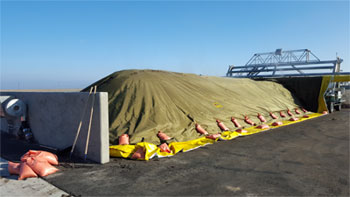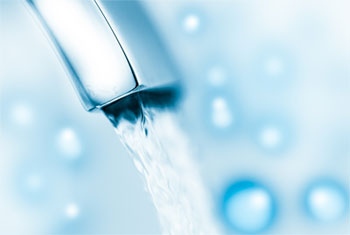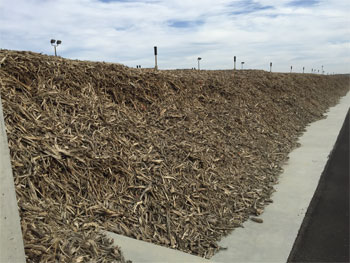
Clean & Green
Closing the Loop

Our natural resources are limited, and we have to find ways to conserve these resources by reducing, reusing, and recycling (“The Three R’s”). Composting at TLC helps California maximize the recycling of our waste that urban and agricultural communities generate by converting waste to beneficial products. Below are a few examples of how TLC closes the loop:
-
Biosolids processed for compost production avoids disposal of the biosolids at a solid waste landfill and contributes to California’s diversion goals and mandates for recycling.
-
In years past, the common practice for managing agricultural waste in the Central Valley was by open burning, but this practice has since been phased out by the San Joaquin Valley Air Pollution Control District. Composting is a viable, environmentally responsible alternative for managing Central Valley’s agricultural waste and green waste.
-
Recycling of these materials and utilization of Class A Exceptional Quality compost as a soil amendment is an EPA-approved practice that provides benefits to both municipalities and the agricultural community.
Clean and Green

Every aspect of TLC was designed with the environment and our neighbors in mind. This commitment to being Clean and Green starts with the facility’s isolated location, which is approximately 4 miles from the nearest community. The truck route to the facility from Interstate 5 is a short trip that avoids passing by any homes or businesses. In addition, TLC’s Administrative Office Building is LEED (Leadership in Energy and Environmental Design) Certified. Additional eco-friendly features include:
-
Specially engineered probes and controls to optimize composting temperature and oxygen levels, resulting in lower energy usage.
-
A composting process that greatly exceeds EPA’s standards – pathogens are destroyed for a period six times longer than required, and Vector Attraction Reduction (VAR) is double EPA’s requirements.
-
Water cannons installed in the Mixing and Receiving Building ensure that biosolids truck trailers are cleaned of all residues. In addition, a wheel wash station ensures that no feedstocks or compost are tracked offsite.
Protection and Conservation of Water

In order to preserve the Central Valley’s water resources, a strong emphasis was placed on water conservation. All storm water, process water, and compost leachate at the site is recycled back into the composting process. The resulting net water usage of TLC is less than one-half the water used to cultivate almonds or most other orchard trees on the same acreage. The underlying groundwater, which is poor quality, is protected by a 12-inch compacted clay liner beneath the entire site and will be routinely monitored. TLC’s other measures to protect and conserve water include:
-
Class A Exceptional Quality Compost produced at TLC reduces irrigation demand, conserving the Central Valley’s precious water.
-
The site has been graded for onsite runoff to flow into storm basins sized for a 100-year, 24-hour storm event.
-
Storm water and non-potable water basins are completely lined to prevent leakage to groundwater and retain water for reuse.
-
All storm water, process water, and compost leachate is contained and managed on site. There is no runoff or run-on to the site.
-
Approximately 30% of TLC’s water use will come from water recycled during the composting process.
-
All compost leachate is recycled back in the composting process for added nutrients.
-
All materials handling surfaces are lined and covered with asphalt or cement to limit dust.
-
The facility has been designed to meet Title 27 standards and requirements for groundwater protection (same as standards for solid waste landfills, even though these standards do not apply to the facility).
-
Multiple monitoring wells ensure no groundwater contamination.
Clean Air and Odor Control

California has launched major efforts to protect air quality and reduce greenhouse gases. From hauling to delivery of materials to composting, every aspect of TLC has been designed to keep the valley’s air clean. Below are examples of TLC’s commitment to clean air and control of odors:
-
Natural gas trucks are used to transport biosolids to TLC, which, to our knowledge, is the first time a public agency in California has made this a requirement for commercial hauling of biosolids.
-
Hauling with natural gas trucks result in approximately 17% reduction in the emission of pollution causing compounds that are released by diesel-powered trucks.
-
Biosolids are transported in fully covered trailers and unloaded indoors in the Mixing and Receiving Building to limit odors and other emissions.
-
The Mixing and Receiving Building features high speed roll up doors that close automatically as trucks and other mobile equipment enter and exit the facility to significantly reduce the release of odors and emissions from the building.
-
The Mixing and Receiving Building is under negative pressure (vacuum) to further prevent the release of odors and emissions. An air ventilation system forces the indoor air to an outdoor biofilter, which is approximately ¾ acre in size and has a volume of 200,000 cubic feet.
-
The biofilter is composed of natural, organic materials, such as wood chips, which host microbial organisms that naturally reduce odors and remove up to 80% of volatile organic compounds and 90% of the ammonia in the airstream.
-
Prior to composting, the biosolids and amendments are mixed by either electric-powered stationary mixers or a mixer truck that exceeds the highest California Air Resources Board (CARB) on-road vehicle emissions standards.
-
During the composting process, which fully complies with stringent air quality permit requirements, the aerated static piles of mixed biosolids and amendments are covered with an engineered fabric or a biofilter layer that provides excellent odor control, an 80% reduction in volatile organic chemicals, and a 99% retention rate of particulate matter and bacteria.
-
After the composting process, a trommel screen is used to separate the finished Class A Exceptional Quality compost from larger, bulky material (“overs”). For mobility and flexibility in operations, the screen can be powered by a diesel engine that meets the most stringent state and federal emission standards for off-road equipment (Tier IV Final), or by electricity.
-
Loaders and other heavy equipment used at the site are all powered by engines that meet Tier IV Final requirements.